The causes and interventions of thinning hair
The crowning glory of any individual is their hair. It also acts as a protective shield for your head. It guards your scalp against the harsh UV rays. Hair loss (Read – Causes, Treatments, Home remedies, and More) can be gravely distressing and can affect the quality of one’s life. It has a measurably adverse psychological impact on self-esteem and can lead to feelings of worthlessness. Hair thinning and hair loss affects both men and women. The good news is that it does not result in baldness in all cases. But if not attended to soon enough, the damage is irreversible. The condition of thinning hair involves either a mild or moderate loss of hair. This causes thin spots of hair to appear on your head. The process occurs gradually and is not instantaneous.

What causes Hair Thinning
To find a solution to the problem of hair thinning, we must first determine what causes it. We can only find a long-term solution if we can get to the root of the problem. You may be losing your hair for the following reasons:
1. Stress
After a long period of excessive stress, there is significant thinning of the hair. This is known as telogen effluvium. Usually, it occurs three months after the stressful event, and it may take three months after the stress period has ended for hair growth to resume. In most cases, the damage is reversible unless the person is predisposed to genetic or Androgenic Alopecia.

2. Alopecia Areata
This type of condition causes hair thinning and hair loss by the immune system reacting to hair follicles and shutting them down. The hair loss is limited to a particular area, and all the hair in that area is lost completely. It is less severe than alopecia total is, in which all hair is lost completely.
3. Postpartum pregnancy
A few months after giving birth, women notice their hair falling excessively. This is due to a drop in estrogen levels. Postpartum hair loss peaks four months after giving birth. It again comes under telogen effluvium and usually resolves itself without requiring any medication.
4. Iron deficiency
In an iron deficiency, the body doesn’t produce enough red blood cells for oxygen to reach the tissues. Hair thinning is one of the symptoms of fatigue, irregular heartbeats, shortness of breath from exertion, and headaches. Pregnant women are also at a greater risk of developing anemia, particularly when there are multiple pregnancies in a shorter period. Blood tests can be used to diagnose this condition.
5. Eating disorders
In eating disorders, the body is deprived of the necessary nutrients required to perform the day to day activities. With the lack of nutritious vitamins and adequate protein, thinning of hair is commonly seen in patients suffering from anorexia nervosa and bulimia.
6. Age
In old age, hair growth slows down, so most people experience some hair loss. As we age, the hair follicles on our scalp stop growing hair, which causes the hair on our head to thin. Additionally, the color of the hair starts to fade. It is natural for a woman’s hairline to recede over time.
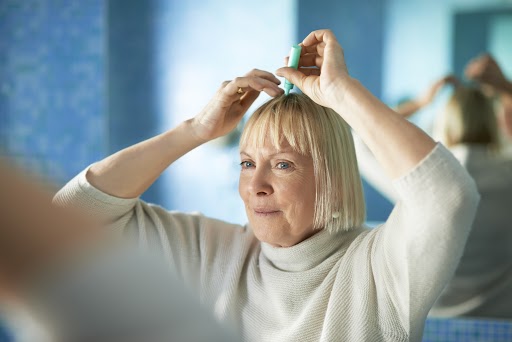
7. Certain hairstyles
It is possible to recede your hairline and thin your hair when you wear your hair in a tight ponytail or create tight hairstyles. Creating sleek straight hair requires a lot of heat. Hair loss can also result from this.
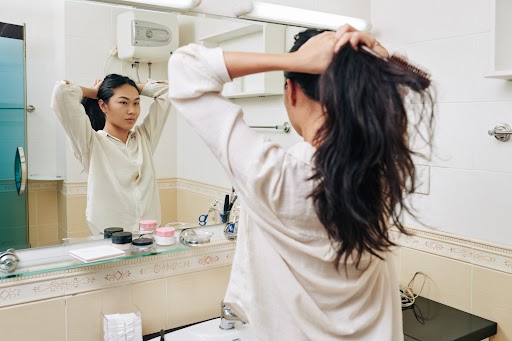
How to prevent Hair Thinning?
1. Massaging the scalp
The most convenient, cost-effective, and available thinning hair treatment at home is oil massage. It does not have any side effects and is safe for everyone to use. Apply some oil on your palm and gently massage it into your scalp using circular motions. Remember to wash your hair before applying oil to your hair. This will encourage blood flow which would increase the regrowth of hair.
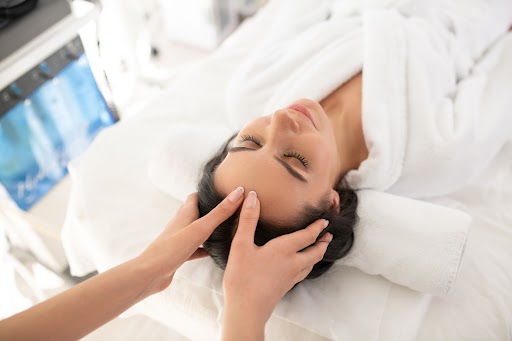
2. Anti thinning shampoo
Anti thinning shampoo works in two ways, it adds volume to your hair, and secondly, it is enriched with the essential oils and nutrients to nourish the hair. They contain amino acids which make the scalp healthy and the hair stronger.
3. Omega 3 and Omega 6 fatty acids
Omega 3 helps to take care of inflammation which is the primary cause of premature hair loss. Omega 6 is made up of essential fatty acids. This takes care of the overall health of the skin, including the scalp. These essential fatty acids are usually found in fish. But it can also be consumed in the form of supplements.
4. A well-balanced diet
A study conducted in the year 2018 revealed that a well-balanced diet consisting of fruits, vegetables, and protein would reduce the risk of alopecia or at least slow the process. Fill your diet with food rich in vitamin A such as sweet potatoes, sweet peppers, and spinach.

5. Reduce the use of heat and chemicals
Refrain from using too many styling tools. Avoid using harsh chemicals found in cheap hair dyes and bleaches. This may lead to breakage and thinning of hair. Switch to natural products to style your hair instead.
6. Refrain from over-washing your hair
Frequent use of shampoo or conditioner can strip your hair of its natural oils. Dry hair can break off easily, resulting in thin hair. While shampoo can remove all the dirt from your hair and scalp, it should not be overdone.
7. Choose hairstyles that do not put extra tension on your hair
Chronic stress on your hair follicles can result in traction alopecia. Hairstyles that are too tight can cause such damage to hair follicles. Opt for looser, more comfortable hairstyles to prevent any damage.
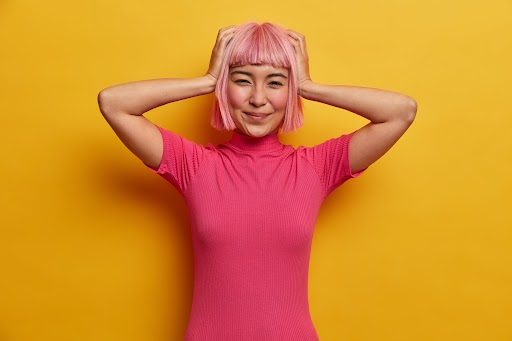
Treatments available for thinning of hair
If you notice that you have been losing more hair than usual for a considerable period, you might consider visiting a dermatologist or trichologist. Some of the treatments available for hair loss are as follows:
1. Minoxidil
This medication comes in the form of foam or liquid for direct application to your scalp. You can buy it over the counter without requiring any prescriptions.
2. Finasteride
You can only buy it with a prescription, and it comes in the form of a pill. It takes months to see results. Do not abruptly stop taking this medication, or else it might give rise to more hair fall.
3. Microneedling
The process of micro-needling is done with the help of a device that has several tiny needles attached to it. Micro-needling may work better when combined with another hair loss treatment, according to research. You can get this device without the prescription, but you should consult your dermatologist before doing so.
4. Hair transplant
In a transplant, your surgeon removes individual hairs and transplants them to thinning or balding areas. The surgery takes almost 4-8 hours. The results are permanent.
5. Low-grade laser surgery
This treatment is beneficial for people suffering from alopecia areata, patients undergoing chemotherapy, and for people recovering from a hair transplant.
6. Platelet-rich plasma
In this procedure, the dermatologist draws out blood from the patient, separates the plasma from the blood, and injects the plasma into the scalp. The procedure takes around ten minutes. Most people get this treatment in the interval of 3 months.
Natural ways to regrow your hair at home
1. Aloe vera

Aloe vera is well known for its hair growth properties. It soothes your scalp and gets rid of dandruff. It also unclogs the hair follicles and removes excessive oil. Pure aloe vera gel can be applied several times a week to your scalp either directly or by diluting it with oil. Read – Benefits of Aloe Vera for hair!
2. Onion juice
Onion juice has shown very positive results in treating alopecia. It promotes circulation. Blend a few onions and get the juice out of it. Apply the juice to your scalp and leave it for ten minutes. Then wash your hair normally with shampoo.
3. Lemon juice
Lemon juice is said to enhance the quality of hair drastically. Apply freshly squeezed lemon juice to your scalp and leave it for fifteen minutes before you wash it off with shampoo.
If you want to take care of thinning hair, you have to be consistent. Hair growth is a time-consuming process, and it does not happen overnight. Choose the remedy which is best suited for you and your hair type and stick with it. In case of serious conditions, take help from a dermatologist who will help you with coming up with the best possible solution. Stay positive and maintain an overall healthy lifestyle along with the treatment to see the best results.
Reference :
https://www.medicalnewstoday.com/articles/325307#treatment
https://www.webmd.com/skin-problems-and-treatments/hair-loss/hair-loss-causes-women
https://www.aad.org/public/diseases/hair-loss/causes/18-causes

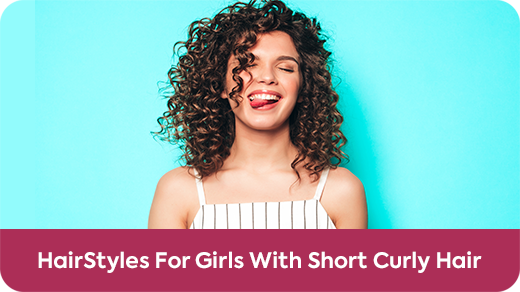

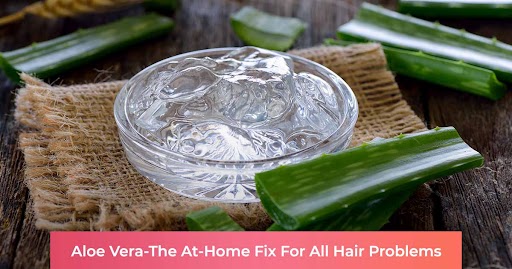
Some times its a pain in the ass to read what blog owners wrote but this website is really user genial! .